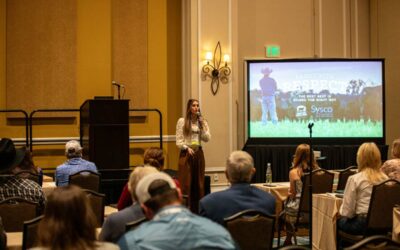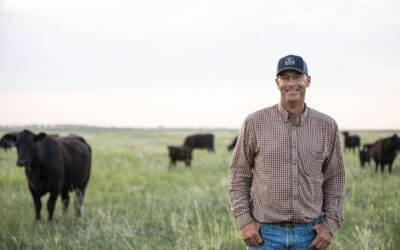
Prepping for no rain
To get a little perspective on what a commercial and registered Angus producer in Kansas is doing to deal with the drought, read on. Then if you have any tips to offer, please leave a comment. I’ll be sure Barb sees them. Thanks! –Miranda
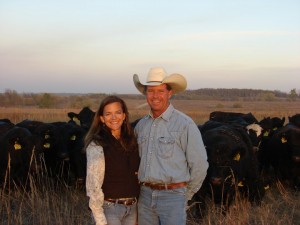
We’re in year 3 of a bad drought. The last 2 have given us 1/3 of our “normal” rain fall. We have not had a run-off event (for ponds) in 14 months. Most of our rain has come in 1/4″ to 1/2″ rains on hot windy days.
Our focus is on preserving producing cows. As such, we’ve taken some pretty aggressive steps this past year.
1. Early fenceline weaned spring calves to lighten loads on pastures, lower cow energy demands, etc. All weaning done by Aug. 17 for calves born in March/April.
2. VAC45’d and sold our entire spring calf crop with the exception of bull and replacement heifer candidates. Normally, we would grow the calves through January then send them to the feedyard. Breakevens were neutral to positive, so keeping feed resources tipped the balance to selling calves.
3. Have one pivot; harvested corn, baled the stalks and planted grazing crops. Will be used for calved-out cows in an intense, rotational system.
4. Planted more grazing crops (converting some brome to other grazing crops) but that was a miserable failure for the 2nd year in a row.
5. Rebuilding existing stock ponds. Continuing installation of controlled access drinking points (all ponds) and waterers below ponds where feasible.
6. Worked with a local rural water district to institute an emergency water access plan. Basically, you can buy a meter ($3,000) but let it go inactive when no longer needed.
7. Weaned and sold entire fall-born calf crop (September and October born, sold mid-January). Because of feed situation, we did not fenceline wean & precondition– something we’ve done for years and years. Again, we’d normally retain ownership. We’re lightening feed needs, getting in some of the breeding season with no nursing calves (hopefully getting more cows bred), decreasing water demands and easing up grazing on spring and summer pasture, assuming there is some.
8. Are setting up to early wean spring calves as conditions dictate. Again, March/April calves and will probably start weaning in June.
9. Bought more cone feeders (low waste) and will unroll less hay this year and use more feeders.
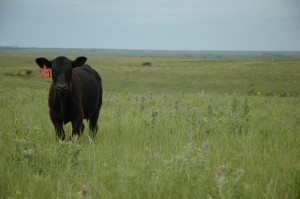
At this time, we still have open spring-born replacements in the pipeline. We may look at shipping them out for development or selling them outright. We kept no fall replacement heifer candidates. Bulls are on test at our partner’s facility but will be done in mid-March. Typically, they’re out on range April-October, but who knows???? They may end up in lots for the summer — not a good situation in our opinion but what are you going to do? We may not have bull customers come fall anyways.
If/when we start culling producing cows, we’ll use production records and age to make those lists. Another thing we’re considering is to set up and synchronize cows/heifers as we’ve always done and just keep the ones that AI; no clean up bulls. This summer, we’re also planning on pregging early (probably blood, maybe ultrasound) and getting open cows gone right away.
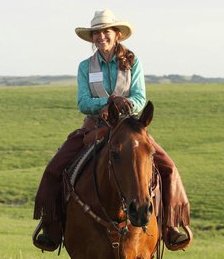
Again, everything we’re doing is geared to protecting our production unit; our range and our cows. Dropping cow numbers drastically will have effects for years to come while losing $70/head of grid, ASV premiums and the like will affect us financially for 1 to 2 years. Having said that, weather conditions are looking more like we will be dropping cow numbers drastically, but that will be our LAST resort.
I would LOVE to hear how you all are prepping & dealing with drought. I need more ideas and suggestions!
Praying for rain while prepping for none,
Barb Downey
PS–If you’d like to join the CAB list-serv, just e-mail Steve and he’ll get you added.
You may also like
Get BQA’d, Meet Coach Tang at Hy-Plains Feedyard
Get BQA’d, or renew an expired certification, on Wednesday afternoon, August 21, 2024, at Hy-Plains Feedyard in Montezuma, Kan. Hear from Jerome Tang, K-State’s men’s basketball coach, about how it takes every player on a team to win. The workshop is free to attend and will offer simultaneous Spanish interpretation.
Raised with Respect™ Cattle Care Campaign Launched This Fall
Raised with Respect™ was developed as part of a strategic cattle care partnership between Sysco and CAB. The collaboration focuses on supporting farmers and ranchers, equipping them with continuing education to stay current on best management practices and helping to increase consumer confidence in beef production.
Everything They Have
Progress is a necessity on the Guide Rock, Nebraska, ranch where Troy Anderson manages a commercial Angus herd, small grower yard, his 10-year-old son, and a testing environment. Troy’s approach includes respect for his livestock, people and land. For that, Anderson Cattle was honored with the CAB 2023 Commercial Commitment to Excellence Award.


